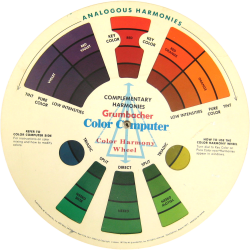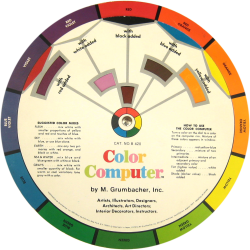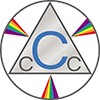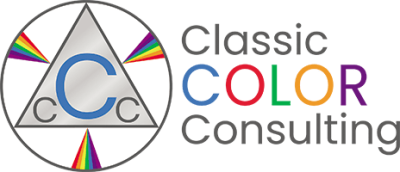Color Computer
The Color Computer is an easy to use tool that can help you visualize color harmonies and results of various color mixes. There are a few Color Computers on the market developed by the different manufacturers. The one I use is by M. Grumbacher, Inc.
This is simply a cardboard disk with twelve colors of the standard color wheel printed on either side. Two additional cardboard disks, with window cut outs in them, are attached to both sides of the original disk so as to sandwich the original disk in the middle. There is a metal rivet that goes through the center of all three disks. As the outer disk is turned on its axis (like a dial), the results of various color combinations, etc. appear in outer disk windows.
The side A of the Color Computer indicates analogous and complementary harmonies. Just select the color, you want to build harmony for, in the “Color Key” window and the arrows will point to true, split and triadic complementary as well as analogous harmonies. The other side (side B) lets you see what happens when each one of the twelve colors of the Color Wheel is mixed with red, blue, and yellow. It also shows tints and shades for each one of the twelve colors.
As was mentioned before, the Color Computer can be very useful in color scheme building because it helps us visualize color harmonies. For example, let us say we have a room with lots of red furnishings (red mahogany stained wood furniture, red rug and a brick fireplace.) The walls are painted a light tone of yellow.
In terms of color, such a room may feel a bit off balance. If you look at the side ‘A’ of our Color Computer, you will see that adding a little bit of blue (perhaps a vase or an accent wall) to your color scheme will will help with adding to the color balance you are seeking. This is because blue will nicely fill-in the missing element to a triadic color scheme and will make our color scheme: red, yellow and blue – the most classic triad of them all.
Side A

Side B

There are various computer software programs that can be similarly used, but I think its much easier to carry thin piece of cardboard on the way to a project. So, I am sticking with my manual Color Computer. I have owned the one you see in the picture above for over 30 years. Not a bad deal for under ten bucks!




